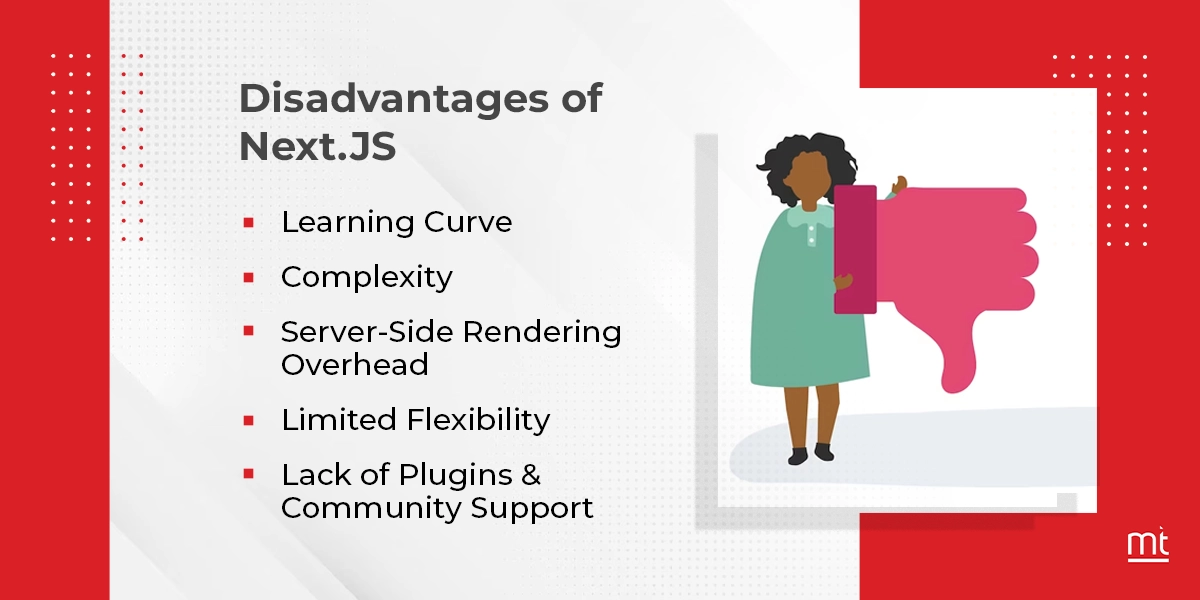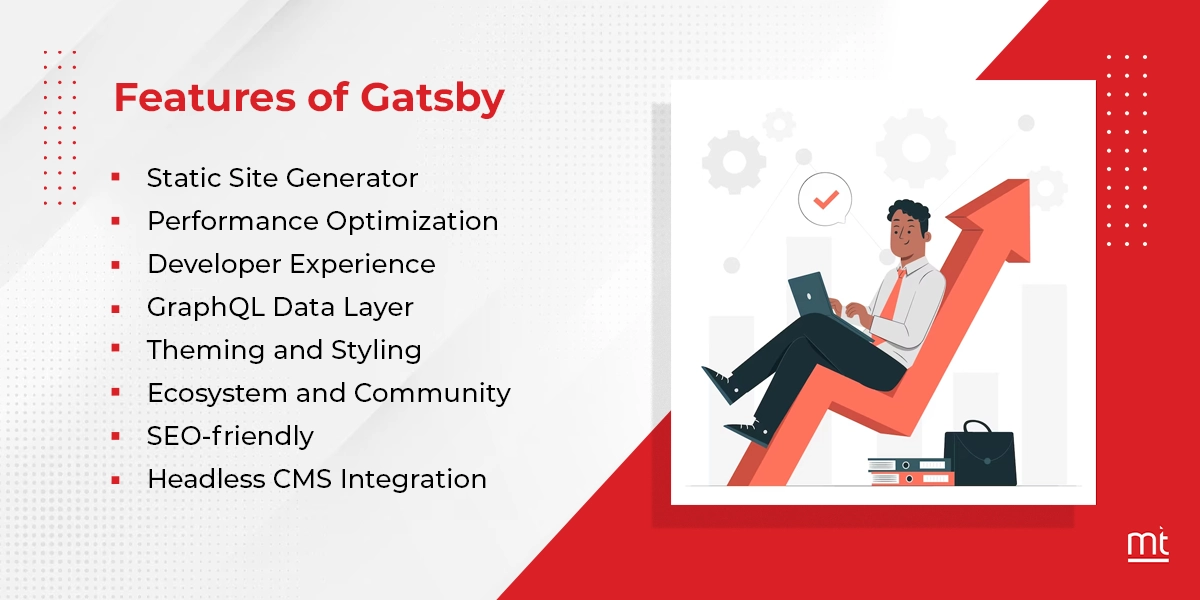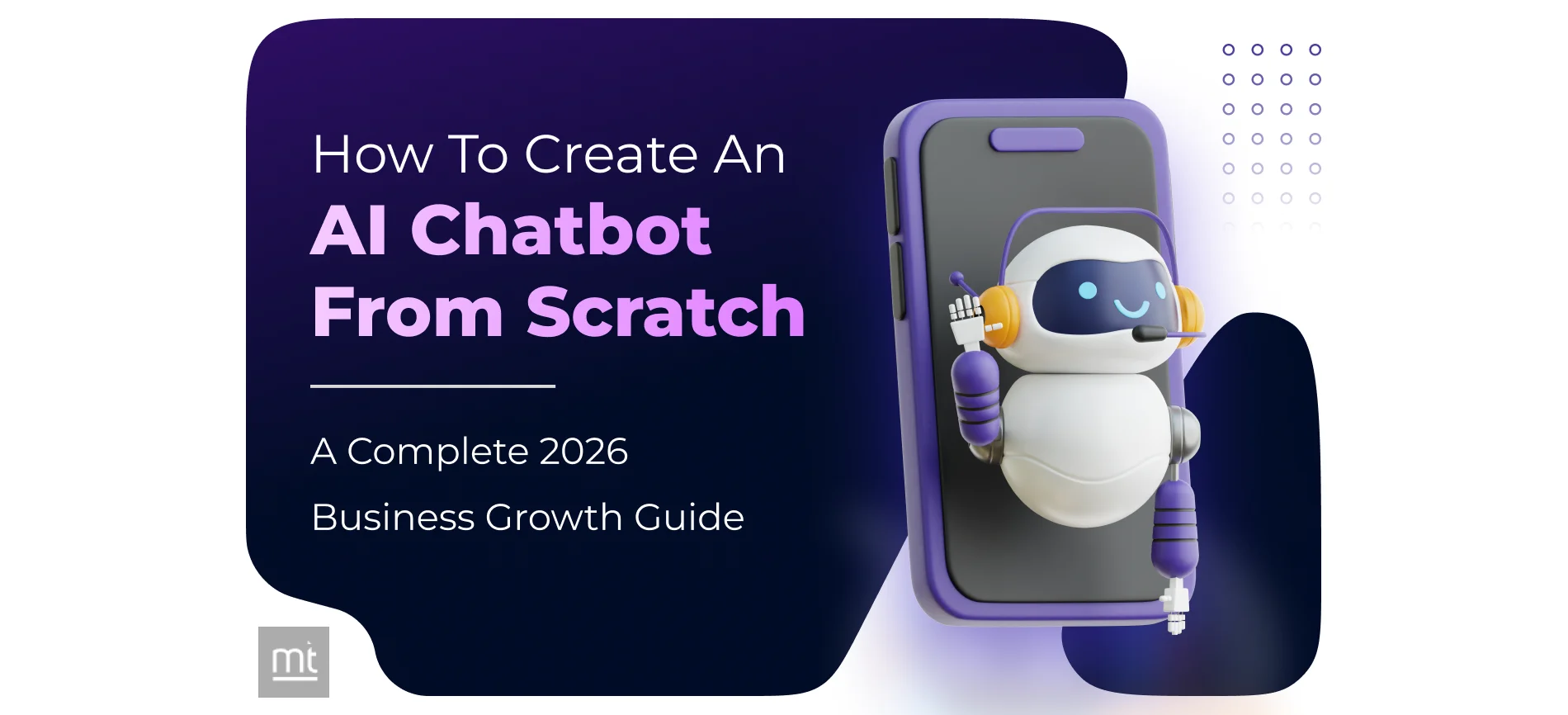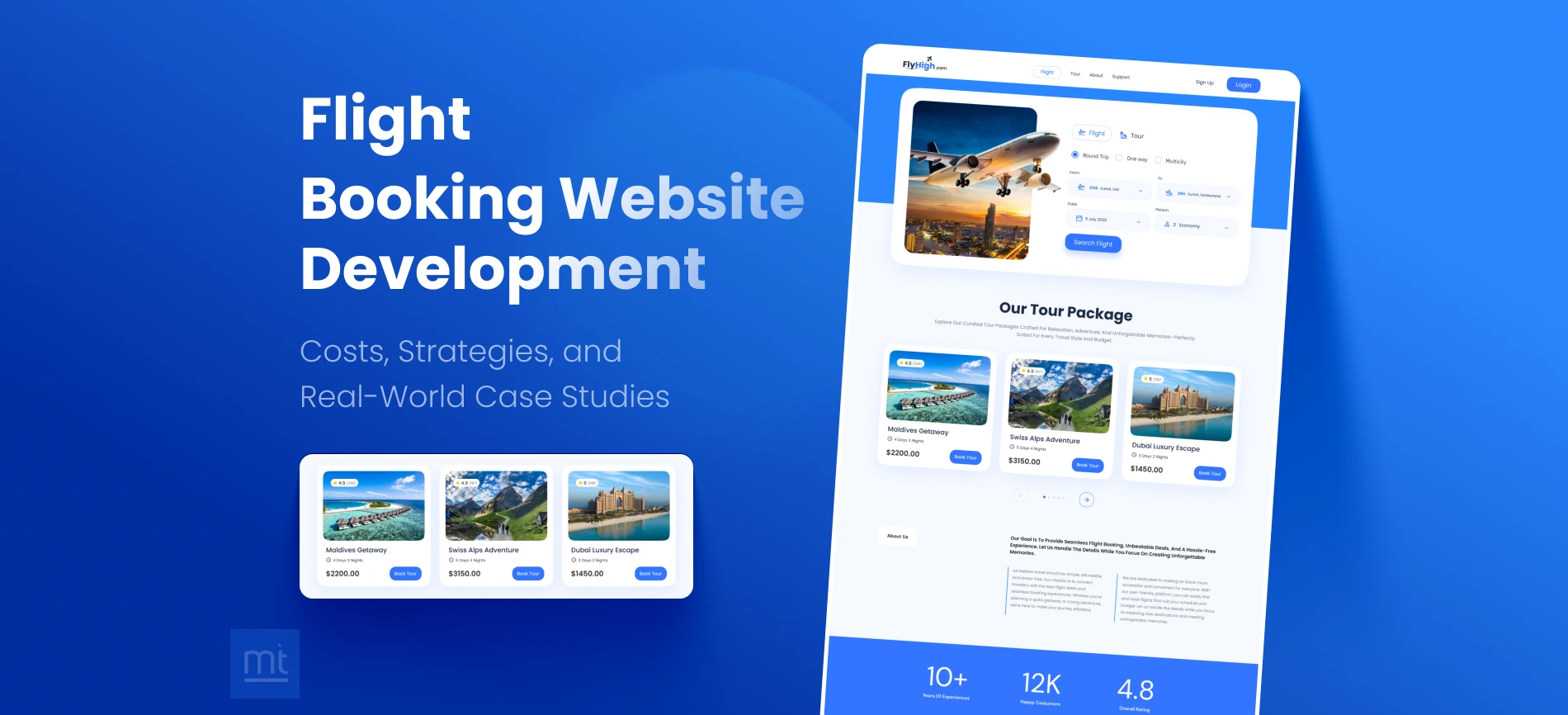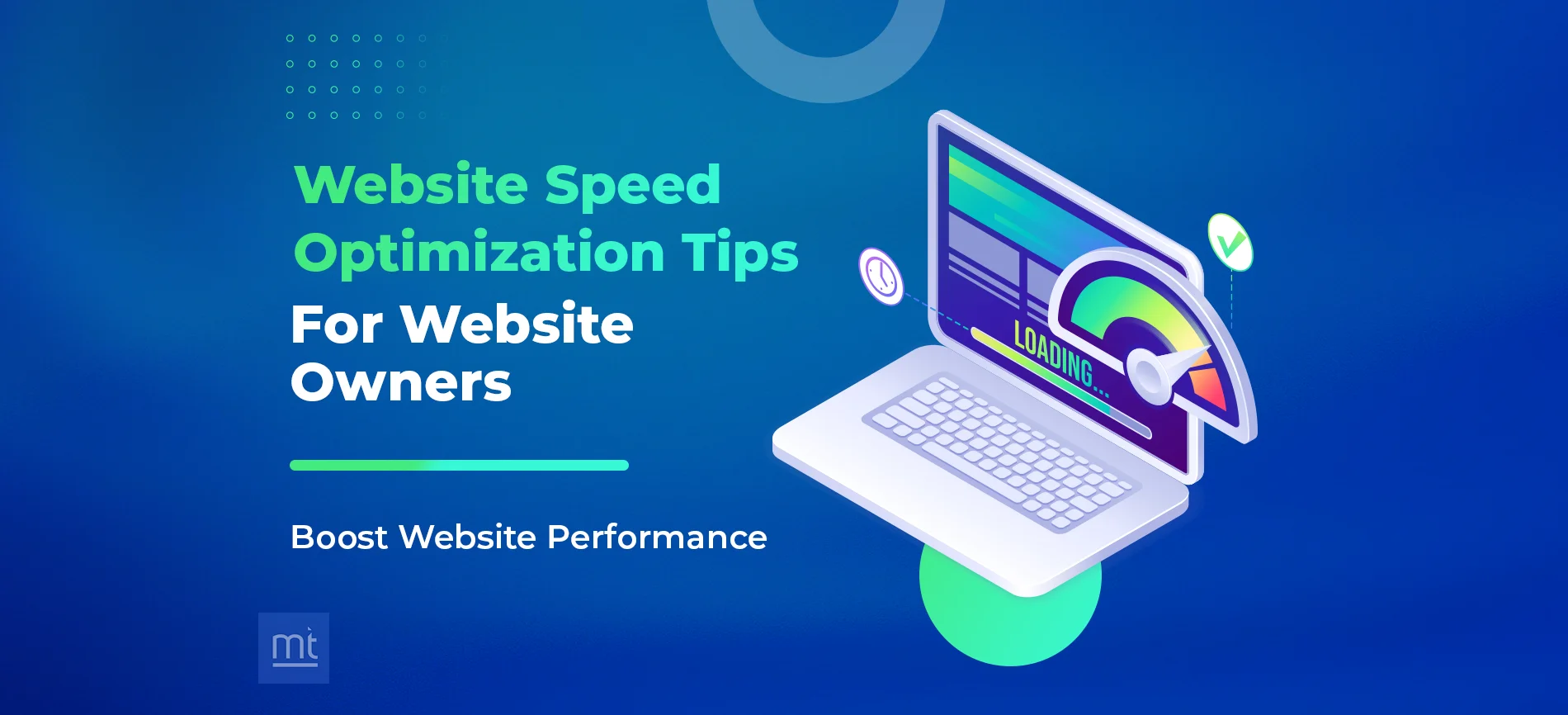Get Free Trial Week Developer Access, Try Before You Hire. Click Here to Claim Now
Introduction: Gatsby vs Next.js
Next.JS and Gatsby are two of the most popular React frameworks developers use to build responsive websites. They are called static site generators to build robust and SEO-friendly websites.
React is a JavaScript library that does not need any introduction. As per the Stack Overflow Survey 2022, React is one of the most preferred libraries to build static websites. React has made the web development process easier and quicker with some excellent features and benefits.
With React, you can easily abstract DOM manipulation and build more dynamic websites with versatility and flexibility. Furthermore, it has a comprehensive set of routing, data fetching, and state management libraries.
When you choose React, you have a library, not the whole framework. React helps you in rendering the UI. Developers need to think of other frameworks to build the front-end architecture.
It brings you to the crossroads. Though React has many frameworks, you need to compare Next.JS Vs Gatsby. Developers love both these frameworks, which have a wide range of tools and features. They simplify web development for developers with unique features like server-side rendering, plugins, image optimization, etc.
Now, over time, both these frameworks have many similarities and differences. To choose one, you need to have a proper understanding of both these frameworks.
This post discusses both these frameworks in detail to help you choose the right one for your next project.
What is Next.JS?
Next.JS can be your best friend if you want to build highly scalable and responsive websites. Being a JavaScript framework, Next.JS can help statically exported React applications. With the fantastic tools that Next.JS has to offer, developers can build server-rendered websites with dynamic webpage content. With Next.JS, developers can develop websites with almost zero configuration.
Next.JS-powered websites can generate HTML templates with every new request. Next.JS has features like automatic code-splitting, single-file components, and hot code reloading.
Getting started with Next.JS is also easy for developers. All they need to do is to go for a CLI command called create-next-app. By doing it, they will have full access to an extensive list of additional commands for Next.JS resources like additional libraries, languages, tools, and well-maintained documentation. The learning curve of Next.JS is simple and linear. You can easily hire remote dedicated developers with relevant experience and expertise for your project.
Advantages of Next.JS
Next.JS offers some amazing benefits to developers and organisations to reduce the app development time and effort.
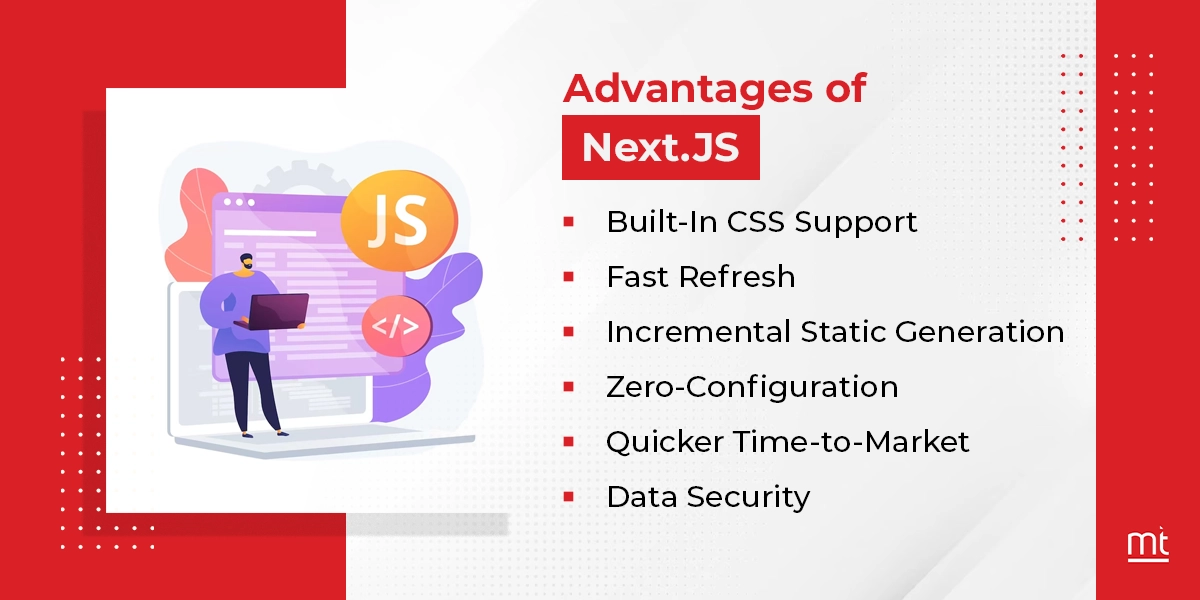
1. Built-In CSS Support
With Next.JS, you have built-in CSS support to import CSS files from JavaScript.
2. Fast Refresh
The Fast Refresh feature allows you to view changes without refreshing the page.
3. Incremental Static Generation
Next.JS performs website rendering in the background as traffic arrives. Developers can easily update web pages and turn a static website into a dynamic one.
4. Zero-Configuration
Next.JS eliminates the need for website configuration with features like automatic compilation and packing. You can focus more on the logic of your app and not on configuration issues.
5. Quicker Time-to-Market
Developers can use ready-to-use components to build MVPs faster. You can get feedback instantly, make changes in the MVP, and reduce the development time.
6. Data Security
Static websites made with Next.JS don't interact with databases directly, making it challenging for hackers to breach security.
Disadvantages of Next.JS
Let’s check out some limitations of Next.JS that you should know of.
1. Learning Curve
If you are a developer and need to gain skills in React and server-side rendering concepts, you might need some time to get familiar with Next.JS and its concepts. You will have to allocate some time to learn the framework.
2. Complexity
Next.JS is a prevalent and powerful framework but also brings some complexity. For smaller projects, this is unwarranted and unnecessary complexity, which also increases development time and effort.
3. Server-Side Rendering Overhead
The best benefit of Next.JS is that it turns against itself sometimes. For example, server-side rendering improves performance but also causes potential performance overhead. You will need caching strategies to balance performance and server load.
4. Limited Flexibility
You will see some conventions and opinions that Next.JS follows. However, it also limits the framework's flexibility. Consider other frameworks if you have specific project requirements that fail to align with Next.JS conventions.
5. Lack of Plugins and Community Support
Next.JS does not have a large number of plugins and active community support. Developers might need help with developing applications.
Features of Next.JS
Discussing the features of Next.JS will shed some light on how you can use this robust framework.
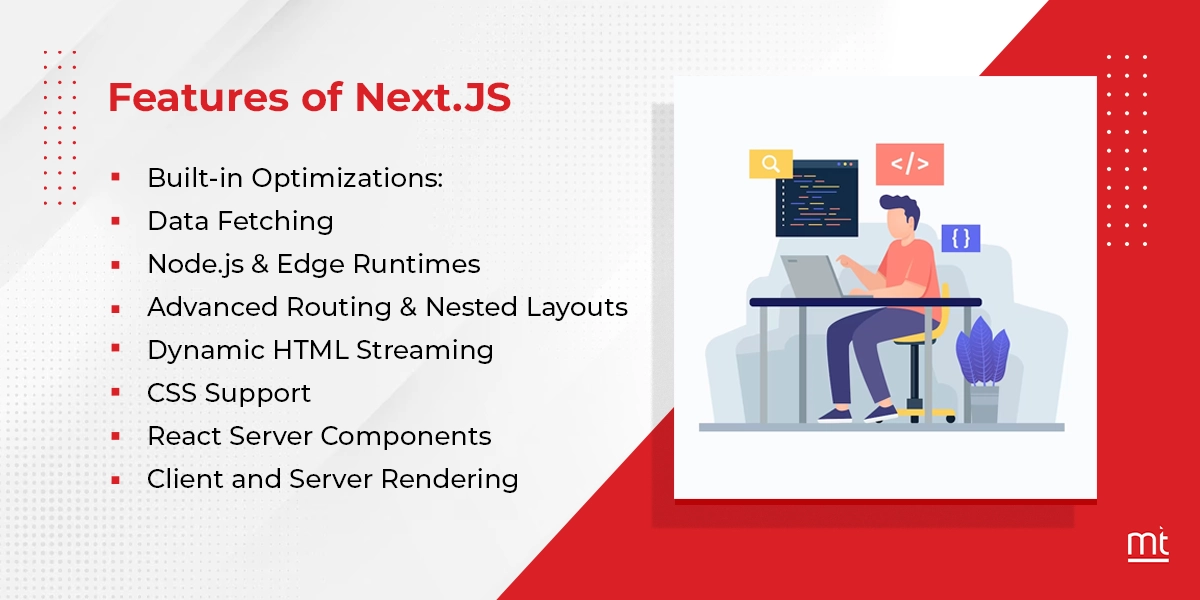
Built-in Optimizations
Next.JS has an in-built capability of optimising images, scripts, and fonts to improve the app's performance.
Data Fetching
Data fetching from server-side and client-side is possible with Next.JS. Developers can make React components asynchronous.
Node.js & Edge Runtimes
The Edge network in Next.JS allows developers to build highly scalable solutions with serverless functions and deliver dynamic, personalised content.
Advanced Routing & Nested Layouts
You can create routes using the file system, routing patterns, and UI layouts.
Dynamic HTML Streaming
Developers can stream UI from the server and integrate with the App router and React suspense.
CSS Support
With Next.JS, you can have styling applications with tools like Sass, Tailwind CSS, and styled JSX.
React Server Components
Developers can easily add components without sending additional client-side JavaScript.
Client and Server Rendering
With Next.JS framework, client-side and server-side rendering is possible, with high-end flexibility and caching options.
Read This: Top 10 Web App Ideas That Will Work Wonders In 2024
What is Gatsby?
Gatsby is also a static site generator and a framework based on React. Developers can build highly scalable, rich, and user-centric websites and applications using powerful technologies like GraphQL and Webpack.
Gatsby offers more benefits than a standard dynamic CMS used to build static websites. The best thing about Gatsby is that it is a framework that can be deployed to any host or platform. It is easy to use, highly secure, and rapid.
Gatsby generates static HTML pages that offer excellent performance and speed. With Gatsby's built-in PWA support, you can create instantly loading websites and applications that load critical assets first and then the remaining ones on the following pages.
Advantages of Gatsby
Let's discuss some advantages Gatsby has to offer:
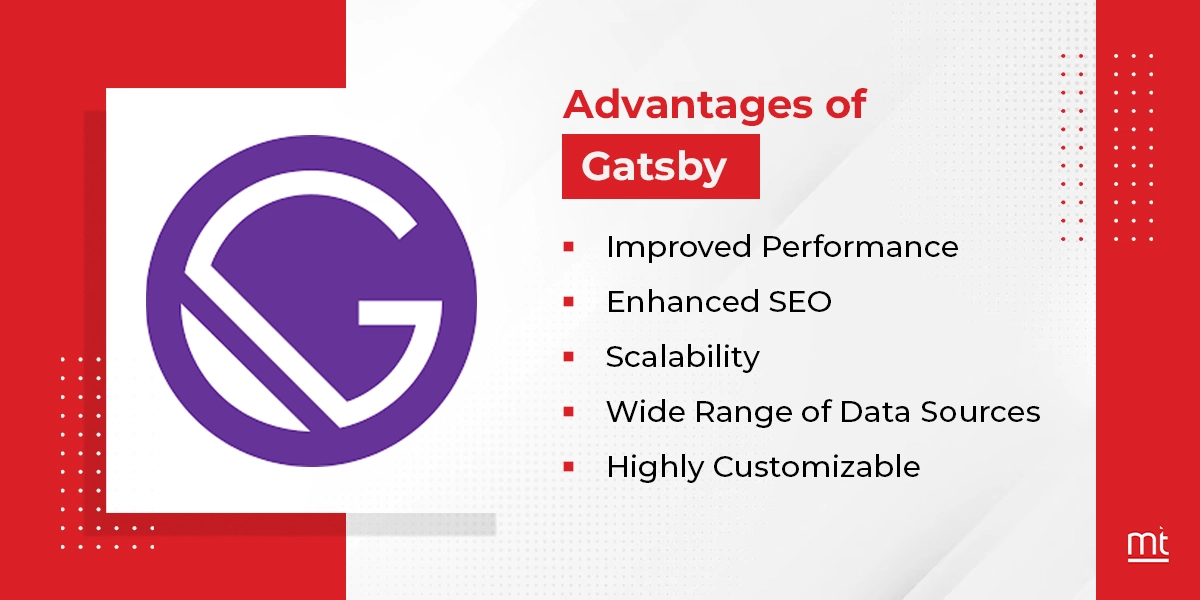
1. Improved Performance
The best thing about Gatsby is the performance. It can quickly generate static HTML, CSS, and JavaScript files, so faster page loading is possible. It improves the website's overall performance and offers your target audience a seamless and excellent experience.
2. Enhanced SEO
Gatsby is an SEO-friendly framework that generates optimised HTML and metadata. Search engine crawlers find it very easy to crawl and index web pages.
3. Scalability
The static site generation methodology allows websites to handle high traffic on them. Websites can take a lot of traffic without compromising performance, speed, and stability.
4. Wide Range of Data Sources
Gatsby can pull data from CMS platforms, markdown files, APIs, and databases. Developers efficiently use various data tools and sources to build scalable websites.
5. Highly Customizable
If you want a tailor-made website with customization possibilities, Gatsby makes it possible. Hire dedicated remote developers with expertise in the Gatsby domain to build highly customised websites.
Disadvantages of Gatsby
Gatsby has some limitations as well. Before you choose Gatsby for your project, know about its limitations.
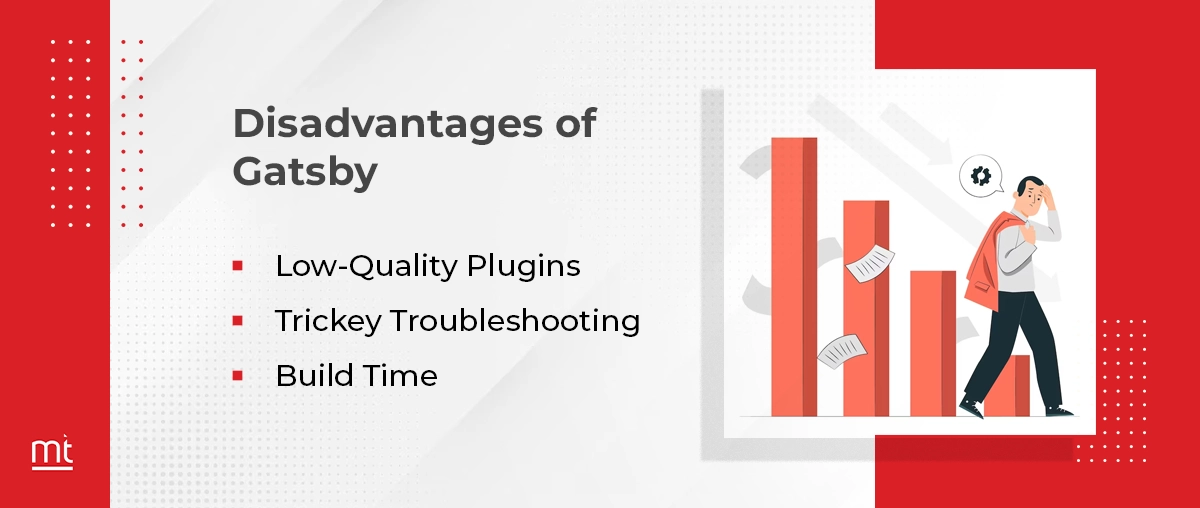
1. Low-Quality Plugins
Gatsby's ecosystem is highly advanced, and developers must switch between different GitHub repositories during development. Everything you want is already created and updated by someone. However, it also makes it difficult for developers to ensure their plugins function as intended.
2. Trickey Troubleshooting
Developers can save a lot of time with the preset functionality presented by Gatsby. However, it would be challenging for developers to troubleshoot issues when something goes wrong.
3. Build Time
When some changes have been made to the website, administrative users would love to see those changes reflected on the website instantly. However, it takes a 1 to 3-minute delay before these changes are reflected on the website.
Features of Gatsby
Gatsby has some amazing features that make web development easy and streamlined.
Static Site Generator
Gatsby is a static site generator that first builds the website into static HTML, CSS, and JavaScript files. These files can then be served from a content delivery network to load faster.
Performance Optimization
You can have an optimised website performance as Gatsby performs automatic tasks such as code splitting, image optimization, lazy-loading, and data prefetching. It loads pages faster and offers excellent performance.
Developer Experience
Thanks to the Gatsby ecosystem and plugins, developers have a great time developing websites with Gatsby. You can automate various tasks with these incredibly powerful plugins. Also, they allow developers to customise the website per the expectations and requirements.
GraphQL Data Layer
GraphQL is a layer allowing developers to query and manage data from different sources. For example, you can easily pull data from a CMS, databases, APIs, etc. This feature makes it easy for developers to handle different data sources.
Theming and Styling
CSS-in-JS libraries, such as Styled Components and Emotion, make it easy for developers to theme and style websites. They can quickly write modular and scoped CSS in their native components.
Ecosystem and Community
Gatsby has a highly vibrant ecosystem and an inclusive community. Developers can use various resources like plugins, starter kits, themes, online tutorials, etc. It makes the whole development process easy and streamlined.
SEO-friendly
If ranking on search engines is your priority, Gatsby is your framework. It automatically generates static HTML files, and that too with optimised metadata. Websites get more visibility and top rankings on SERPs.
Headless CMS Integration
Integrating Gatsby websites with headless CMS systems like WordPress, Contentful, and Sanity would be smooth sailing. Content editing would be easy with such integrations with content management systems.
Similarities Between Next.JS and Gatsby
Before we compare Gatsby vs. Next.js, let's check out some similarities between these two frameworks.
1. SEO Optimization
Both Next.JS and Gatsby have SEO optimization capabilities with SSR and plugins. Both these features make it easy for developers to export and import HTML components to CND databases. It improves the overall page loading speed.
2. Incremental Build
The Incremental Build feature allows developers to change the content without updating the page. You can build pages instantly by reducing the development time.
3. Built-In Performance and Caching
Both Next.JS and Gatsby offer a performance-catching feature that allows developers to speed up the development process by eliminating the need for code splitting and optimising.
4. Developer Experience
Highly exclusive documentation is available for both of these frameworks. Developers can easily set things up quickly and without any headaches. Also, they can add more features and functionalities to the existing product without delay.
5. Dynamic Web Development
Both frameworks offer dynamic web development with advanced features like asynchronous prefetching of pages, pre rendered HTML, hot reloading, etc.
Gatsby vs Next.JS: Head-to-Head Comparison
We will compare Next.JS Vs. Gatsby.JS frameworks for various aspects of development. It will give you a clear picture of which is more suitable for your project.
1. Data Handling
With Next.JS, developers can use and manage data in any manner they want. Gatsby offers a specific method of fetching and handling data using GraphQL.
Gatsby allows you to fetch only the essential data for each page. Also, Gatsby has a wide range of plugins to connect with various data sources. Next.JS does not have any specific data handling and management rules. It is totally up to developers to use the data as they want. They can use various methods such as SSR, SSG, or prerendering for data fetching.
2. Page Rendering
When we compare Next.JS Vs. Gatsby for page rendering, Gatsby, being a static site generator framework, generates HTML pages during the build time. You don't have to use a Node server for rendering. If you have a large website with hundreds of HTML templates, there might be better approaches than building a web page.
Next.JS PWAs render pages with SSR usage. For each request you receive, you must install Node.JS and NPM for HTML rendering in the runtime. Next.JS runs the app with hydration once the HTML is loaded.
3. Extensibility
You have to consider this aspect when you want to add extended functionalities to your app or website. Gatsby has many tools and plugins with features like pre-configured themes, compressed images, TypeScript compilers, etc. Also, Gatsby allows you to customise these themes and functionalities per your business requirements.
On the other hand, Next.JS has a comprehensive set of partner tools and libraries. You can use built-in pages like code splitting, page routing, and image optimization.
4. Scalability
If you want to create a high-scale website or app, there are better choices of frameworks than Gatsby for your project. You can use this framework to develop static web pages or personal blogs. However, if you have scalability goals, there are better options than Gatsby.
Next.JS is the right choice if you want to develop a large-scale website or app or have scalability goals in the future. You can create highly versatile, compatible, and flexible websites or apps that can handle massive traffic without compromising performance and speed.
5. Documentation
When we compare Gatsby Vs. Next.JS, for documentation, both these frameworks excel in this aspect. Both frameworks have comprehensive documentation. Starting with both frameworks would be smooth sailing for developers. If you have worked with React before, you will not have any issues while working on these frameworks.
The documentation covers almost everything from the basics to developing a website. Such highly advanced and detailed documentation helps developers to build highly scalable websites and apps.
6. Community
Vercel owns Next.JS, and the company hires ambassadors to update the community's content regularly. You will have the latest information and content on their Twitter and YouTube handles. Also, you can refer to their blog to find the latest trends.
Gatsby also has a robust and active community. Developers can quickly get quick solutions by chatting with the representatives. However, Next.JS offers more detailed support as it has many resources available for developers.
7. Security
Next.JS CMS and APIs are secure, but they have data present in the server. It might cause security vulnerabilities. On the other hand, Gatsby offers information from the source only, making it more secure and safe.
Gatsby vs. Next JS: Highlighting A Few Use Cases
Now, let’s check out the types of websites and which framework to choose to build websites.
1. Static Websites
When you want to build a static website, Next.JS and Gatsby can help you. However, Gatsby is a more popular choice for static web development. Let's check out why.
The best thing that favours Gatsby for static web development is its ability to separate data and websites. Even other team members can edit content on web pages during run time. Also, Gatsby supports integrating with other content management systems, databases, GraphQL, and REST APIs via various plugins.
2. Large, Multi-User Websites
Multiple users can join and comment on the content page in multi-user websites to update content quickly. Here, developers have to show dynamic content for each logged-in user. The system should be so perfect that once the changes are made in the content, users can see them instantly on the website. For that, you will need server-side rendering to handle such modifications based on authentication. Next.JS is the perfect choice for multi-user websites.
3. Hybrid Web Applications
For hybrid web apps, developers must use SSR to handle data to CSR. Next.JS is the perfect choice here. Next.JS offers both client-side rendering and server-side rendering features. Twitter is the best example we can discuss here. You will see initial tweets via SSR when you open the Twitter home page without logging in. When you scroll down, you will see the next set of tweets via client-side rendering.
Next.JS vs. Gatsby: Real-Life Website Examples
Next JS Examples of Websites
- TikTok
- Netflix
- Hashnode
- Twitch Mobile
- Hulu
- Ticket Master
- Deliveroo
- AT&T, etc.
Gatsby JS Examples of Websites
- Digital Ocean
- AutoloadIT
- SendGrid
- HASURA
- Roboto Studio
When to Choose Next.JS?
When building a large-scale application or website, going for Nexct.JS makes sense. Next.JS can handle much data and content without compromising performance and speed. Also, Next.JS offers high scalability.
When to Choose Gatsby?
When working on a relatively small project where stability and consistency are essential, you can go for Gatsby.
Conclusion
When you compare Next.JS Vs. Gatsby, both frameworks are ideal for different project requirements. Both are React-based frameworks with a simple learning curve and offer various benefits. Both offer a wide range of features to reduce the app-to-market time and improve the performance and speed of websites and apps.
You can choose Next.JS or Gatsby for your web app development project, depending on your project requrements.
Recent Blogs
Subscribe to Our Newsletter!
Join us to stay updated with our latest blog updates, marketing tips, service tips, trends, news and announcements!

